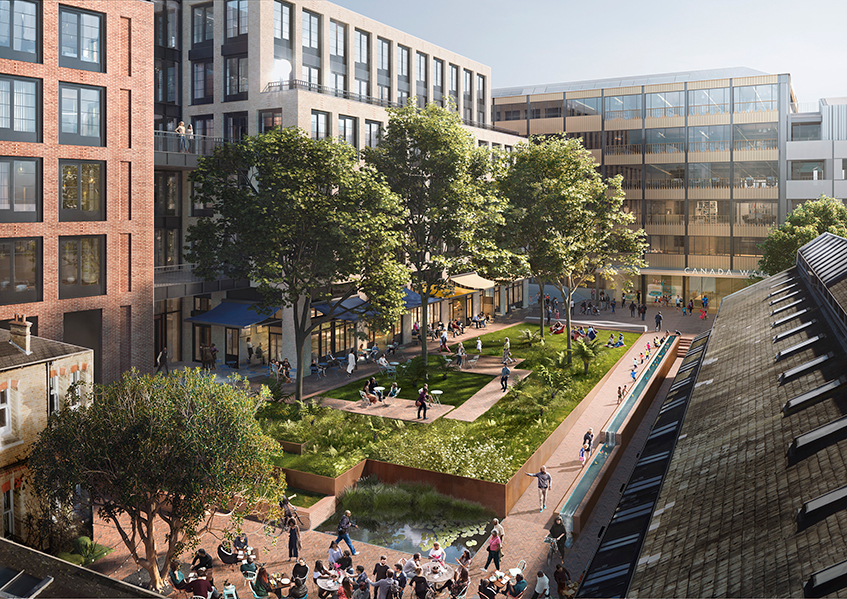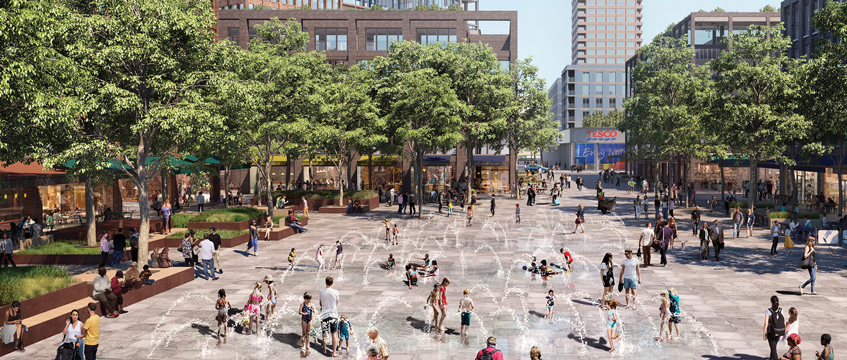Two weeks and eight hours of deliberation over two separate planning meetings and British Land has finally got consent for its £3.3bn scheme in Canada Water, SE16.
Last week, rival developers and objectors were able to throw pointed barbs at British Land over the project. This week, British Land had its say.
The heated debate raised several questions over whether the local transport infrastructure would be able to handle the scheme and laid bare the growing competition between British Land and Canary Wharf Group.
Heated debate
CWG initially raised concerns over British Land’s plans to create the mixed-use development, which sits close to its own established estate and upcoming Wood Wharf scheme, in August last year.
It said British Land was underestimating the demands on public transport and the impact the scheme would have on the Jubilee Line.
Shortly after, both parties issued a joint statement claiming it was “not unusual for developers to submit objections to neighbouring schemes”. The statement said discussions were ongoing and it was expected that “a number of issues” would be “resolved over the coming weeks”.
But fast-forward more than a year to part one of the planning committee meeting and CWG does not appear to consider all the issues to have been resolved.
In fact, CWG managing director for strategy Howard Dawber went so far as to call on Southwark’s planners to defer or refuse British Land’s permission until the REIT had committed to contributing around £200m to the Jubilee Line to negate the project’s impact.
He reiterated CWG’s belief that local residents were being “short-changed” and said CWG had put £700m into transport, the developers at Battersea Power Station put in £300m towards the Northern Line extension, while £250m was paid at King’s Cross.
“Here [in British Land’s application] there’s nothing remotely equivalent,” he said, adding that its community infrastructure levy rates were also two-thirds less than CWG’s.
British Land is expected to pay £90m in section 106 funding and £60m in CIL payments, of which £33m is towards transport. And Dawber’s concerns about public transport being unable to cope with the extra demand were mirrored by residents who felt that Transport for London’s recently announced improvements would “do nothing to assist in relations to Canada Water and the pressures”.
In part two of the planning committee meeting, Emma Cariaga, joint head of Canada Water for British Land, hit back saying: “I am here to set out our ambitious plans for a new town centre that local people and future generations deserve and to balance some of the submissions from objectors, including one that focused on pure commercial self-interest by a developer in a neighbouring borough.”
TfL said it was satisfied that the £32.5m package of transport mitigation measures will be secured in the s106 agreement.
Viability issues
In the 14 months it has taken British Land to get in front of Southwark’s planning committee the firm has agreed to increase the affordable housing provision in the scheme from 35% of phase one to 35% of the overall residential provision within the masterplan.
This has made the scheme “not viable currently,” as British Land would make a sub-market return instead of its targeted 16% profit, says Cariaga. She adds it was “deemed acceptable” for British Land to target 16% profit on the gross development value given the scale of the project and risk involved.
During those 14 months British Land also secured £39.1m in grants to support the viability of the development, but it says it’s still not enough. The funding is being provided by the Affordable Housing Grant from the Greater London Authority (£21.6m) and the mayor of London’s £112m Strategic Investment Fund (£17.5m).
Cariaga says British Land has decided to take on the extra risk posed by upping the affordable housing as it expects “to grow values over time”. Delivery of the scheme is expected to take 10 to 15 years.
If British Land does manage to achieve a 16% return, it has agreed to give Southwark up to 5% more affordable housing. However, residential values would need to grow by 10% to achieve this.
House prices in inner London have been falling since January last year, although the speed of decline slowed in the second quarter of 2019, according to the GLA. Average house prices in London were 4.3% lower in May 2019 than in May 2018.
Cariaga says British Land has accepted a lower level of return as its position as a long-term landlord meant it could “take a slightly different stance to a housebuilder which is more short-term focused”.
“We know from our experience at Broadgate and what we’ve done at Paddington that investing in the public realm you create great places and you do see rents and values respond positively and over 10 to 15 years we feel confident that we will get to a level of profit that the industry has deemed acceptable,” she says.
The REIT, subject to mayoral approval, expects to start on site at the 53-acre project in the middle of next year.

To send feedback, e-mail louise.dransfield@egi.co.uk or tweet @DransfieldL or @estatesgazette











